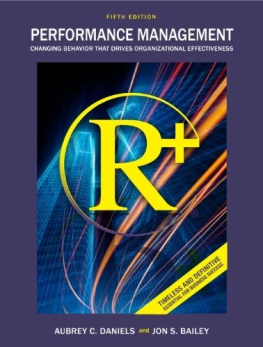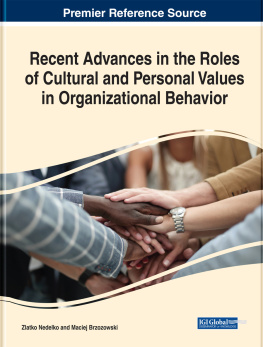WARNING
The purpose of the following work is non-commercial and only for study.
Some pieces of the book may be missing. The page count, and others items may not be the same place as the original book.
If you can, please buy the book.
Performance Management:
Changing Behavior That Drives Organizational Effectiveness
Fifth Edition, Revised
Aubrey C. Daniels, PhD. and Jon S. Bailey, PhD.
Performance Management Publications,
a division of Aubrey Daniels International, Inc.
Original cover art by Bill Morse.
5thedition cover design by Lisa Smith
Published by Aubrey Daniels International, Inc.
3344 Peachtree Road NE, Suite 1050
Atranta, GA 30326
www.aubreydaniels.com
This book was set in Garamond Premier Pro.
Editor: Gail Snyder
Production Coordinator: Laura-Lee Glass
Graphic Artist: Lisa Smith
Copyright 2014 by Performance Management Publications. All rights reserved. No part of this book may be reproduced in an form, eletronic or mechanical, including photocopy, recording, or any information storage and retrival system, without permission in writing from the publisher.
Library of Congress Control Number: 82-061868
International Standard Book Number: 978-0-937100-25-7
Printed in the United Stats of America
2 3 4 5 6 7
PREFACE
Preface to the Fifth Edition
This book was first published in 1982. It is difficult to believe that 32 years have passed since that edition. During that time I have had three co-authors: Ted Rosen, Jamie Daniels and Jon Bailey. Dr. Bailey is the current co-author. I met him in 1986 and we have worked together since. For the last 25 years, I have participated periodically in Performance Management (PM) classes that Dr. Bailey taught at Florida State University. Since Jamie, the previous co-author, has retired, Jon was the natural choice for this edition.
Dr. Baileys classes were amazingly effective and he created PM zealots, many of whom are active in the field of Organizational Behavior Management (OBM) today. As such, he brings an in-depth knowledge of the science of Behavior Analysis and more than two decades teaching students Performance Management, using this book. The knowledge he has gained from those activities and his own research, has added much toassist the reader in understanding the science and its application in the workplace.
The 1982 edition was written primarily for front-line supervisors and managers of industrial organizations, since little was available for training them at that time and there were almost no courses about applying the principles of behavior analysis to any workplace. Since that time the book is now used in over 100 colleges and universities in psychology and business courses. Over a half million copies are in print today.
Because the first edition was written to help business managers and supervisors apply what they learned to solve real business problems, we learned about what worked and what didnt in real workplaces solving real business issues. What we learned has resulted in the writing of the four other editions. The book has been tested literally around the world in thousands of locations with countless behaviors.
When Dr. Bailey and I started to revise the book, we discussed the need to shape the book more carefully to those who are just learning about PM, especially university students. Jon pressed me to convert the book from a, What PM is to a How to Do PM text. We both know that the best way to understand PM is to take on a project from the beginning and follow it all the way through to completion including a presentation of the findings to a target audience. Dr. Bailey modified the order in which chapters were read by students in his now-famous FSU undergraduate class, INP 3313 Behavior Analysis in Business and Industry. Over the last 20 years, hundreds of students have learned PM by conducting projects in Tallahassee often with outstanding results.
Those readers who have read previous editions will notice several obvious changes. The first and most obvious is the chapter order mentioned above. The order of the chapters in Edition 5 is the order that Dr. Bailey has used very successfully in his course. It is ordered to facilitate application and we hope it accomplishes that. In addition, references have been updated so as to have examples of applications from the modern workplace, although older studies are still as applicable to behavior today as they were when they were done, since the laws of behavior have not changed in the last 32 years.
Although this book is a science book, we hope it is not as hard to read as a research journal. Where we were able, we used nonscientific terms and everyday language to make the reading easy and the concepts clear. Hopefully in doing so, we did not sacrifice scientific accuracy for clarity. For example we write from time to time that the supervisor reinforced the programmer for Weknow that you reinforce behavior, not people. However, it makes for easier reading tothe activity that way than to use the more technical description. The reader should be able to tell from the context the behavior that was strengthened. We have included over 150 research articles and papers that the reader can access for further detail about the research methodology on which the researchers findings were based. We have also included QSR codes that make accessing these materials easy on a smart phone, iPad or similar device.
Unfortunately, even though this book in one edition or another has been in existence for 32 years, the use of behavior technology in the workplace is still in its infancy. Since the fundamental laws of behavior dont change, those who learn to apply this technology successfully, will have a clear performance advantage over those who dont.
Thanks for purchasing this book. We hope that using its contents will increase the positive reinforcement that you give and receive.
ACD
JB
ACKNOWLEDGEMENTS
The people who have contributed to this book number in the thousands. The authors have been involved in the practice of Performance Management (PM) for over 45 years. In that time we have been exposed to thousands of people working in many hundreds of organizations, not only in the United States but in over 30 countries. Each person has added to our experience base and each has furthered our understanding of human behavior in the workplace. Without them, this book could not have been written.
The academic community that engages in basics cientific research and teaching in the experimental analysis of behavior has been especially helpful in advancing our knowledge of human behavior over the years. Their research has provided the scientific foundation for our work. Much of their work is referenced in this book. The members of the Organizational Behavior Network have been particularly supportive. Not only have many of them used this book in their classes, but also contribute research that adds to the body of knowledge that supports a more efficient and effective application. We are deeply grateful for the Opportunity to learn from them and for their help in applying these concepts to our own lives and relationships at work and at home. Although it is difficult to list all who have helped us, several have supported us from the beginning. Dr. Alyce Dickinson, Dr. Beth Sulzer-Azaroff, Dr. Richard Obrien, Dr. Tom Mawhinney, Dr. John Austin and the late Dr. Bill Hopkins deserve special mention.
We would especially like to thank those who participated directly in the writing and production of the Fifth Edition. Katrina Bilella searched all the back issues of PM Magazine for topical articles that supplemented the reorganized edition. Lisa Smith did the layout, created many of the new figures and responded cheerfully to all our last-minute changes. Gail Snyder did her usual good job of making sure that we had a readable text and otherwise minded the ps and qs related to grammar. Mary Burch reviewed and edited all of Dr. Baileys new writing. Sandy Stewart kept AD on track by handling the many details for him that would have otherwise extended the completion of this work by many months. Laura Lee Glass managed all the details of printing and distribution to make sure that the book was available before all past editions go out of existence.










